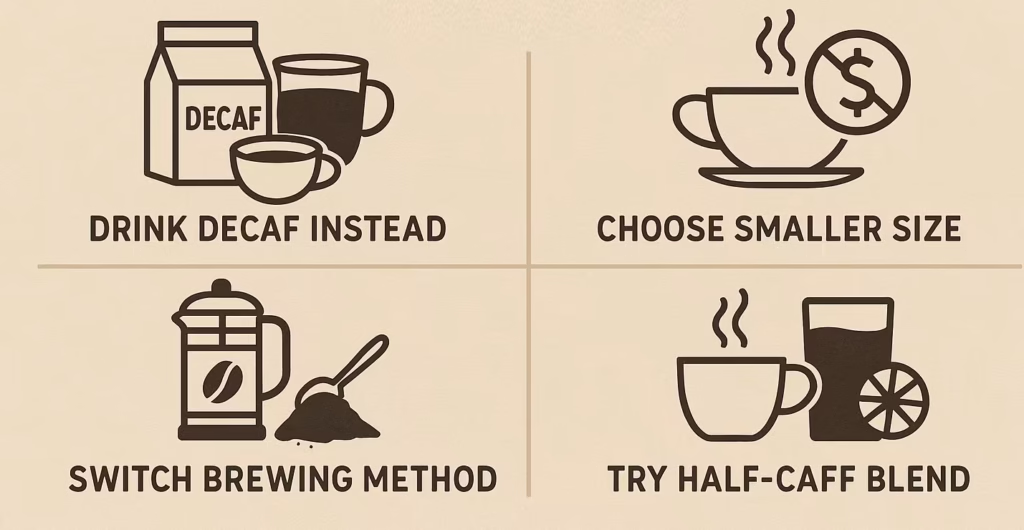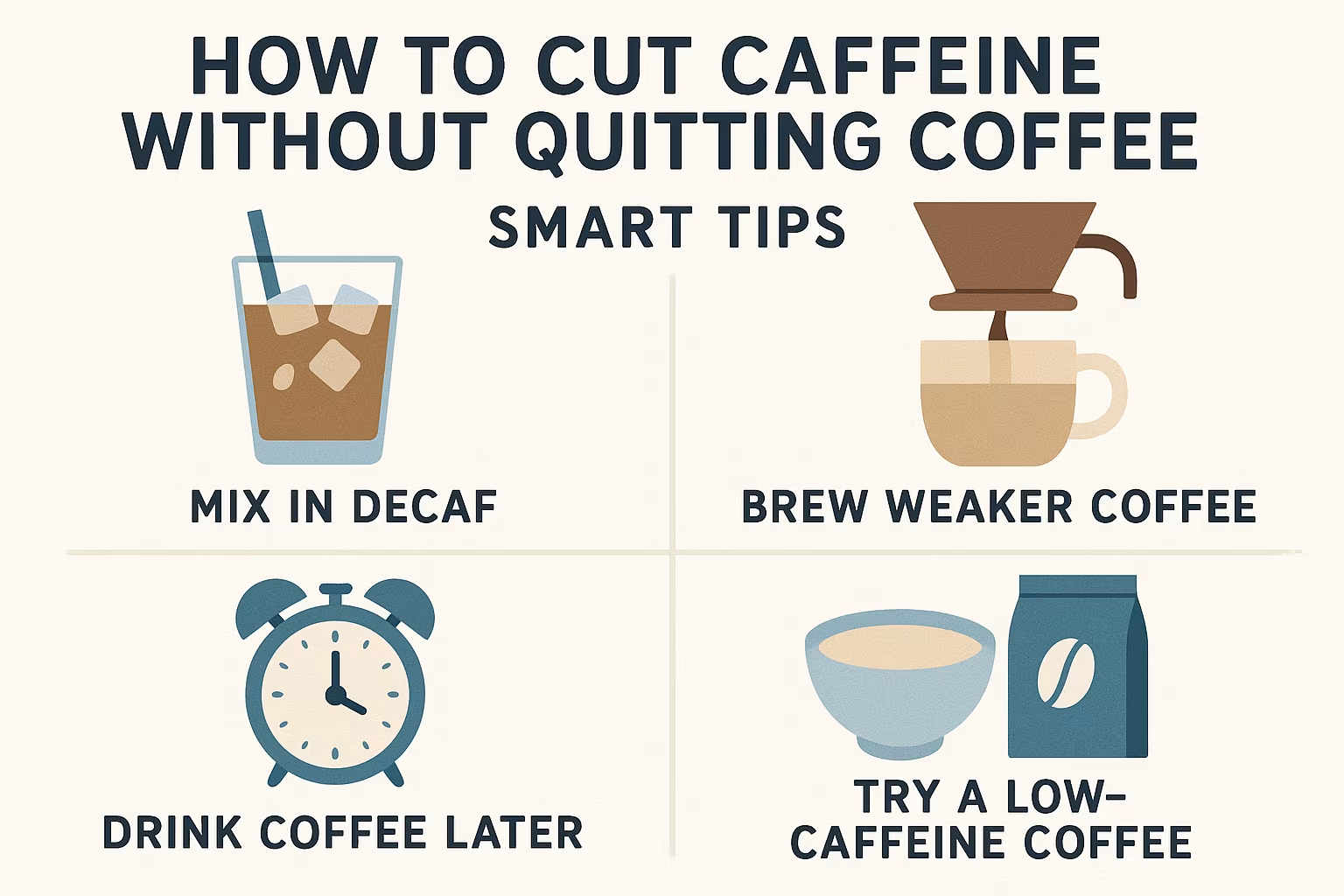Want to keep your daily brew but reduce the buzz? Discover practical strategies on how to cut caffeine without quitting coffee, from smart brewing methods to choosing low-caffeine beans—so you enjoy coffee’s taste without the jitters.
How to Cut Caffeine Without Quitting Coffee: Smart Tips
For millions of people, coffee is more than a drink—it’s a ritual, a comfort, and sometimes even the fuel that powers the day. Yet the reality is that too much caffeine can lead to jitteriness, anxiety, sleep disruption, and even a mid-afternoon energy crash. The good news? You don’t have to give up your daily brew to feel better.
Learning how to cut caffeine without quitting coffee allows you to continue enjoying the rich aroma, taste, and tradition of coffee while taking control of your health. Think of it not as sacrifice, but as balance—something both science and culture have shown to be the key to long-term well-being.
Step-by-Step: How to Cut Caffeine Without Quitting Coffee

The most pressing search intent people have is simple: “How can I reduce caffeine without saying goodbye to my favorite drink?” Here’s a practical, step-by-step guide that helps you manage caffeine while still savoring your cup.
Switch to Half-Caff or Blended Coffee
One of the easiest ways to reduce caffeine intake without losing flavor is to switch to half-caff coffee—a blend of regular and decaffeinated beans. This solution halves your caffeine while keeping the taste and aroma intact. Many roasters now offer high-quality half-caff blends that rival their fully caffeinated counterparts.
Barista tip: If you grind your beans at home, try mixing 50% decaf and 50% regular Arabica beans. This way, you control your blend ratio and adapt it gradually.
Choose Naturally Low-Caffeine Coffee Beans
Not all coffee beans are created equal. Arabica beans naturally contain about half the caffeine of Robusta beans, yet they’re prized for their smoother, sweeter flavor. Some rare varieties, such as Laurina (Bourbon Pointu), are naturally low in caffeine while maintaining complex flavor notes. Choosing these varieties lets you keep your coffee experience rich while reducing stimulant impact.
| Coffee Type | Average Caffeine per 8oz | Flavor Profile |
|---|---|---|
| Robusta | 200 mg | Bitter, earthy |
| Arabica | 100 mg | Sweet, smooth |
| Laurina | 40–50 mg | Floral, light |
| Decaf | 2–15 mg | Depends on process |
This comparison shows how simply switching beans can cut caffeine dramatically without giving up your morning ritual.
Adjust Brewing Methods to Reduce Caffeine
How you brew coffee matters as much as what you brew. A long extraction tends to release more caffeine, while shorter methods can reduce it. For example:
Espresso: Small in volume but high in concentration. Surprisingly, per ounce it’s high in caffeine, but a single shot has less total caffeine than a large drip coffee.
Cold Brew: Often contains more caffeine due to longer steeping time unless diluted.
French Press: Medium caffeine release, but coarser grinds can help reduce extraction.
Pour Over/Drip: Moderate, but adjusting grind and brew time reduces caffeine.
If you want to cut caffeine, experiment with shorter brew times, coarser grinds, and smaller ratios. As the proverb says, “Small keys open big doors”—small adjustments in brewing open the door to healthier coffee habits.
Manage Cup Size and Frequency
You don’t need to eliminate coffee; simply reducing cup size can make a big difference. Instead of a 16oz mug, try an 8oz cup. Instead of three coffees a day, reduce to two and add a decaf option in between. Remember, moderation is the art of enjoying life without extremes.
Why Cutting Caffeine Matters Without Quitting Coffee
Why bother cutting caffeine if you love coffee? Because it allows you to keep the ritual and taste while avoiding the downsides. Coffee’s history stretches from Ethiopian legends of Kaldi’s dancing goats to European coffee houses where intellectuals met to debate ideas. Giving it up entirely would mean losing not only flavor but also a piece of culture. By cutting caffeine instead of quitting coffee, you protect both your health and heritage.
Reducing Jitters and Anxiety
Too much caffeine overstimulates the central nervous system, often causing restlessness or anxiety. Studies show that doses above 400 mg per day (roughly four standard cups) can increase cortisol, the stress hormone. Cutting back can stabilize your mood while still letting you enjoy coffee’s comforting aroma.
Improving Sleep and Energy Balance
Caffeine lingers in the body for 6–8 hours, sometimes more. Drinking strong coffee late in the afternoon can sabotage deep sleep, leading to fatigue the next day. Reducing caffeine—or timing it earlier—improves circadian rhythm and restores natural energy cycles. A balanced coffee routine gives you more sustainable energy instead of temporary highs followed by crashes.
Maintaining Coffee Rituals Without Overload
Coffee is more than caffeine—it’s the ritual of brewing, the warmth of the cup in your hands, the shared moments at cafés. By cutting caffeine instead of quitting, you preserve this cultural and emotional bond. As French writer Honoré de Balzac, who was famously obsessed with coffee, once wrote: “Coffee falls into the stomach… ideas begin to move, things remembered arrive at full gallop, the shafts of wit start up like sharpshooters.” He may have overindulged, but even he recognized coffee’s deeper connection to creativity and life.
Low Caffeine Coffee Options You Should Try
If you’re committed to reducing caffeine, you’ll be pleased to know there are several enjoyable options that don’t compromise flavor.
Decaf vs Half-Caff: Key Differences
Decaf coffee: Typically contains 97% less caffeine than regular. Thanks to improved processes like the Swiss Water Method, modern decaf preserves much of the flavor.
Half-caff coffee: A balanced option for those who find decaf too light. Keeps some caffeine for energy but avoids overload.
Decaf is great for evenings or sensitive individuals, while half-caff works best for morning routines when you want both taste and a gentle lift.
Cold Brew vs Espresso: Which Has Less Caffeine?
It may surprise some readers that cold brew—though smooth in taste—often has more caffeine than espresso because of its longer steeping and higher bean-to-water ratio. Espresso, while intense per ounce, is usually consumed in smaller portions, resulting in less total caffeine. If reducing caffeine is the goal, choose a single espresso shot over a large cold brew.
Specialty Coffees with Lower Caffeine
Coffee innovators are now cultivating beans like Laurina, Excelsa, or naturally low-caffeine varieties that retain complexity while offering gentler caffeine levels. Specialty roasters, including those we feature at Lyoncafe (learn more at mtnlyoncafe.com), are embracing these options for health-conscious coffee lovers. Exploring these varieties can expand your palate while reducing your stimulant intake.
Best Practices for Controlling Caffeine Intake
Cutting caffeine without quitting coffee isn’t only about the beans you choose—it’s also about how and when you drink. The following practices help you enjoy every cup without overwhelming your body.
Timing Your Coffee for Less Impact
Science shows that caffeine interacts with cortisol, a natural hormone that peaks in the morning around 8–9 a.m. If you drink coffee during these peak times, you often experience more jitters and less effectiveness. A better strategy is to wait until mid-morning, around 9:30–11:00 a.m., when cortisol levels dip. Drinking earlier may give you less benefit, while drinking later helps sustain energy without interfering with sleep. Likewise, avoid caffeine after 2 p.m. to reduce the risk of insomnia. As the old saying goes, “The morning cup sets the tone for the whole day.” By timing it right, you set that tone wisely.
Hydration and Food Pairing with Coffee
Dehydration worsens caffeine’s side effects. Pair each cup of coffee with a glass of water to maintain balance. Eating alongside coffee also slows caffeine absorption. A breakfast rich in protein and healthy fats stabilizes your energy, preventing crashes. For example, enjoy your morning espresso with eggs and avocado toast instead of drinking coffee on an empty stomach. This small shift reduces jitters and enhances your body’s ability to process caffeine smoothly.
Track Your Daily Caffeine Intake
Many people underestimate their caffeine consumption because they forget to count other sources: tea, chocolate, soft drinks, or energy drinks. Tracking your intake through an app or journal can reveal hidden caffeine that adds up quickly. At Lyoncafe, we encourage students and clients to log their daily intake for at least one week. This simple awareness often results in natural adjustments and healthier habits.
Common Mistakes When Trying to Cut Caffeine
Even with the best intentions, many people fall into traps that make reducing caffeine harder than it needs to be. Avoiding these mistakes ensures your transition is smooth.
See more: How to Tamp Espresso Correctly: A Barista’s Guide
Abruptly Cutting Coffee Instead of Adjusting
Going “cold turkey” often leads to withdrawal symptoms: headaches, irritability, and fatigue. Instead of cutting coffee entirely, gradually reduce caffeine by blending decaf with regular coffee or switching to smaller cup sizes. Think of it like stepping down a staircase rather than jumping off a cliff.
Ignoring Other Sources of Caffeine
Coffee isn’t the only culprit. Green tea, black tea, soda, chocolate, and energy drinks all contribute to your daily load. Someone may cut their coffee habit in half but still struggle with sleep because of overlooked caffeine in a late-night chocolate dessert or an afternoon cola. Awareness is key.
Relying on “More Cups, Less Strong” Myth
Some assume that drinking more cups of weaker coffee reduces caffeine. In reality, multiple cups of “light coffee” often equal or exceed the caffeine in one regular brew. It’s better to focus on quality over quantity—one small, flavorful espresso or half-caff latte is more satisfying and less harmful than three watered-down mugs.
Barista and Expert Tips for Coffee Lovers
Professional baristas and health experts alike have developed practical tips for enjoying coffee responsibly while still keeping its charm alive.
Pairing Coffee with Relaxation Routines
Coffee amplifies experiences, and pairing it with mindfulness practices like meditation, journaling, or yoga enhances its enjoyment while keeping you grounded. Instead of rushing through your cup on the way to work, take five minutes to sip slowly, focusing on aroma and flavor. This mindful approach reduces the urge to overconsume because you become more satisfied with less.
Choosing Roast Levels for Lower Caffeine
Many people believe dark roast coffee has more caffeine because of its bold taste. In fact, the opposite is true: light roast contains slightly more caffeine per bean because it is roasted for less time. However, because dark roasts are less dense, they can balance out in weight-based brewing. The key takeaway: roast level doesn’t dramatically change caffeine, but personal taste can influence how much you drink. Choosing a roast you truly enjoy may naturally help you drink less.
Experimenting with Brewing Ratios
Baristas often adjust brewing ratios—how much coffee to water—to fine-tune both flavor and caffeine. A lower ratio means weaker caffeine but may still preserve taste. At Lyoncafe, we train coffee enthusiasts to experiment with ratios until they find a sweet spot: strong enough to satisfy, light enough to avoid overload. It’s a personalized journey that makes coffee both enjoyable and sustainable.
Frequently Asked Questions
Does Decaf Still Have Caffeine?
Yes. While decaf coffee removes most caffeine, it still contains 2–15 mg per cup, depending on the process. That’s far less than regular coffee but important for those highly sensitive to caffeine.
Is Cold Brew Lower in Caffeine Than Hot Coffee?
Not necessarily. Cold brew often contains more caffeine because of long steeping and high bean-to-water ratio. If you dilute it with water or milk, you can manage caffeine more effectively.
Can I Still Drink 2 Cups a Day Without Overdoing It?
For most healthy adults, 200–300 mg of caffeine (about two standard cups) is safe. If you space your cups out and balance them with hydration and food, two cups daily is perfectly fine.
Conclusion: Mastering How to Cut Caffeine Without Quitting Coffee
At its heart, learning how to cut caffeine without quitting coffee is about balance, not deprivation. By making small but powerful adjustments—switching to half-caff blends, choosing naturally low-caffeine beans, managing cup size, and experimenting with brewing methods—you can protect your health without sacrificing your ritual. The benefits are immense: fewer jitters, better sleep, more stable energy, and the joy of keeping coffee as a daily companion.

My name is Kara Chavez, and I love coffee. I love making the best coffees – espresso, latte, macchiato. I always strive for perfection in my barista skills, and I take great pride in bringing delicious cups of coffee to my customers.
I’ve been in the coffee industry for many years, and I know everything there is to know about brewing the perfect cup of coffee. My passion for coffee shines through in every cup I make, and I hope you’ll stop by soon so I can share my love of coffee with you!

